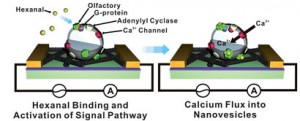Scientists in Korea have developed a biosensor for assessing food quality that mimics the way receptors in a canine nose respond to smells.
Tai Hyun Park and Seunghun Hong and colleagues from Seoul National University made a device that detects hexanal – a volatile compound produced when food is past its best.
A current method to detect compounds emitted by oxidised food is chromatography, but it isn’t portable and it involves a complicated pre-treatment process. To overcome these obstacles, scientists have moved on to semiconductor-based, olfactory cell-based and olfactory receptor protein-based sensors, but they are not as capable as an animal olfactory system in terms of selectivity and sensitivity.
In an animal’s nose, specific odorants bind to the corresponding olfactory receptors with high selectivity, generating a chemical signal. That signal is converted into an electrical signal and then amplified through a pathway in an olfactory sensory neuron (a nerve cell that processes and transmits information by electrical and chemical signalling).
The nanovesicles sit in the carbon nanotube channel. When hexanal is present, it binds to the olfactory receptors, causing an influx of Ca2+ ions into the vesicles. The resulting positive gate potential in the vesicles leads to a decrease in the conductance in the channel
Read the full article in Chemistry World
Link to journal article:
A bioelectronic sensor based on canine olfactory nanovesicle–carbon nanotube hybrid structures for the fast assessment of food quality
Juhun Park, Jong Hyun Lim, Hye Jun Jin, Seon Namgung, Sang Hun Lee, Tai Hyun Park and Seunghun Hong
Analyst, 2012, Advance Article
DOI:10.1039/C2AN16274A











